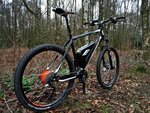Is there a law limiting Ebikes to 36v in Europe?
While there's no overwhelming reason to prefer 48v it does seem to provide a performance boost in most applications. Certainly did in my cordless E lawn mower going from 36-48v.
Given the competitive nature of this biz it just seems surprising that Bosch and others stay with 36v when the cheaper, more powerful options are all using 48v. At least in the US.
Would seem to be a simple switch even if they are limited to 36v in Europe. ?
Maybe our market is still too small to worry about making alternatives a priority?
What's really surprising is no one ever mentions it when discussing bike performance differences.
I don't really "care". Perfectly happy with my 36v Bosch as compared to 48v Easy Motion and current 36v Falco that can be changed to 48v with a battery change. Just curious.
PS - Easy Motion changed the Big Bud Pro from 36v in 2015 to 48v in 2016. Did they change their whole line? It's Spanish I believe.
While there's no overwhelming reason to prefer 48v it does seem to provide a performance boost in most applications. Certainly did in my cordless E lawn mower going from 36-48v.
Given the competitive nature of this biz it just seems surprising that Bosch and others stay with 36v when the cheaper, more powerful options are all using 48v. At least in the US.
Would seem to be a simple switch even if they are limited to 36v in Europe. ?
Maybe our market is still too small to worry about making alternatives a priority?
What's really surprising is no one ever mentions it when discussing bike performance differences.
I don't really "care". Perfectly happy with my 36v Bosch as compared to 48v Easy Motion and current 36v Falco that can be changed to 48v with a battery change. Just curious.
PS - Easy Motion changed the Big Bud Pro from 36v in 2015 to 48v in 2016. Did they change their whole line? It's Spanish I believe.
